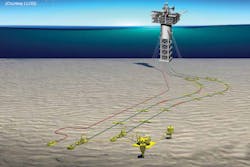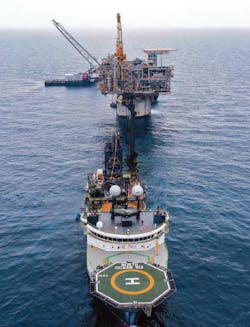Streamlined Buckskin project shows virtues of capital efficiency
Revised field development plan lowers cost by 75%
In these days of capex restraint, LLOG’s successful and timely completion of its Buckskin project in the deepwater Gulf of Mexico provides a case study of how operators can bring their fields online quickly and for less cost than in years past.
The Buckskin field is located in Keathley Canyon blocks 785, 828, 829, 830, 871, and 872 in approximately 6,800 ft (2,073 m) of water. The oilfield is estimated to contain approximately 5 Bbbl of oil in place and initial output is estimated has exceeded 30,000 b/d.
Drilling activities on the project began in January 2018 and first oil was produced in June 2019. Production was achieved with 75% less investment than the initial development plan of $2.25 billion.
Discovered in February 2009 by Repsol, the Buckskin No. 1 well was described as a Lower Tertiary discovery. It was drilled in 6,920 ft (2,109 m) of water down to 29,404 ft (8,962 m) deep, encountering about 400 ft (122 m) of net pay in the Upper and Lower Wilcox formations. The well was drilled by the Stena DrillMAX deepwater drillship. Three subsequent appraisal wells drilled in Keathley Canyon blocks 785 and 829 encountered an average of 375 ft (114 m) of high-quality oil pay in the Upper Wilcox.
After making the discovery, Repsol then handed the baton to Chevron, which served as operator until it left the project in 2015 amidst the industry downturn. Repsol remained in the project and continued to optimize the original development plan to improve the economics. Plans for a new semisubmersible production platform, had been discussed when Chevron led the project, were abandoned.
LLOG joined the project as operator in November 2016 while Repsol stayed on as a partner, along with Beacon Offshore Energy, Navitas Petroleum, and Ridgewood Energy. In September 2017, LLOG announced that the field would be developed with a 6-mi (10-km) subsea tieback to the Anadarko-operated Lucius spar. The new project team selected equipment rated to 15,000 psi, and deployed dual 8-in. flowlines with riser base gas lift.
Under the revised plan, the first phase of field development consisted of two development wells in Keathley Canyon block 829 and a 6-mi (10-km) subsea tieback to the Lucius spar platform at Keathley Canyon block 875.
LLOG contracted Seadrill’s West Neptune drillship to drill and complete the two development wells. Additional tests were conducted based on data collected from the discovery well in order to test the commercial viability of the field.
LLOG says that the project fit in perfectly with its strategy of generating deepwater prospects in areas of past success, and near existing infrastructure.
LLOG officials point out that the company generally does not perform pre-FEED or FEED on subsea work, due to its standardized approach to developments. This, in turn, enables the company to go straight into detailed design after FID. Since LLOG employs the practice of using its standard equipment and standard layouts, there is no need for pre-FEED or FEED work for the subsea aspects of a project.
This strategy, officials say, enables the company to drill and develop its fields in a shorter timeframe, and place them online as quickly as possible. In addition, company officials say that their standardized approach to development allows LLOG to maintain a lower cost structure and generate faster cycle times.
Drilling and completion of the two development wells, which were drilled to about 29,000 ft (8,839 m), occurred in 2018. Installation of subsea facilities to complete the tieback occurred in 2019. The drilling, completion, and subsea installation were completed ahead of schedule and on budget, LLOG said. Philip LeJeune, LLOG’s president and CEO, said Buckskin is the company’s first deepwater development in the Lower Tertiary trend. •
About the Author
Bruce Beaubouef
Managing Editor
Bruce Beaubouef is Managing Editor for Offshore magazine. In that capacity, he plans and oversees content for the magazine; writes features on technologies and trends for the magazine; writes news updates for the website; creates and moderates topical webinars; and creates videos that focus on offshore oil and gas and renewable energies. Beaubouef has been in the oil and gas trade media for 25 years, starting out as Editor of Hart’s Pipeline Digest in 1998. From there, he went on to serve as Associate Editor for Pipe Line and Gas Industry for Gulf Publishing for four years before rejoining Hart Publications as Editor of PipeLine and Gas Technology in 2003. He joined Offshore magazine as Managing Editor in 2010, at that time owned by PennWell Corp. Beaubouef earned his Ph.D. at the University of Houston in 1997, and his dissertation was published in book form by Texas A&M University Press in September 2007 as The Strategic Petroleum Reserve: U.S. Energy Security and Oil Politics, 1975-2005.



